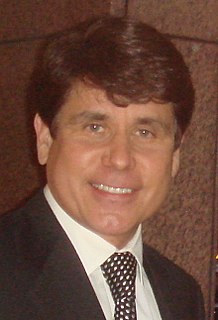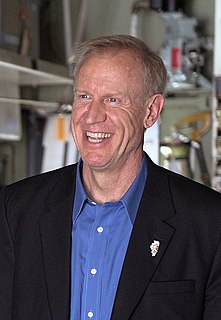| ||||||||||||||||||||
| ||||||||||||||||||||
 County Results Rauner: 40–50% 50–60% 60–70% 70–80% 80–90% Quinn: 60–70% | ||||||||||||||||||||
| ||||||||||||||||||||
| Elections in Illinois | ||||||||
|---|---|---|---|---|---|---|---|---|
 | ||||||||
| ||||||||
| ||||||||
The 2014 Illinois gubernatorial election was held on November 4, 2014, to elect the Governor and Lieutenant Governor of Illinois, concurrently with the election to Illinois' Class II U.S. Senate seat, as well as other elections to the United States Senate in other states and elections to the United States House of Representatives and various state and local elections.

The Governor of Illinois is the chief executive of the State of Illinois, and the various agencies and departments over which the officer has jurisdiction, as prescribed in the state constitution. It is a directly elected position, votes being cast by popular suffrage of residents of the state. The governor is responsible for enacting laws passed by the Illinois General Assembly. Illinois is one of 14 states that does not have a gubernatorial term-limit. The governor is commander-in-chief of the state's land, air and sea forces, when they are in state service.

The Lieutenant Governor of Illinois is the second highest executive of the State of Illinois. In Illinois, the lieutenant governor and governor run on a joint ticket, and are directly elected by popular vote. Candidates for lieutenant governor ran separately in the primary from candidates for governor until 2014, when the system was changed to allow the gubernatorial nominee of a party to select the nominee for lieutenant governor. When the Governor of Illinois becomes unable to discharge the duties of that office, the lieutenant governor becomes acting governor. If the Governor dies, resigns or is removed from office, the lieutenant governor becomes governor. Under the Illinois Constitution, the Attorney General is next in line of succession to the Governor's office after the lieutenant governor, but does not succeed to the Lieutenant Governor's office. From the impeachment of Rod Blagojevich in 2009 until the inauguration of Sheila Simon in 2011, Attorney General Lisa Madigan would have become Governor if Pat Quinn had vacated the office. Historically, the lieutenant governor has been from either the Democratic Party or Republican Party. The current lieutenant governor is Democrat Juliana Stratton.
The three classes of United States Senators are made up of 33 or 34 Senate seats each. The purpose of the classes is to determine which Senate seats will be up for election in a given year. The three groups are staggered so that senators in one of the groups are up for election every two years, rather than having all 100 seats up for election at once. For example, the 33 Senate seats of class 1 were up for election in 2018, the elections for the 33 seats of class 2 will take place in 2020, and the elections for the 34 seats of class 3 will be held in 2022.
Contents
- Democratic primary
- Candidates
- Endorsements
- Polling
- Results
- Republican primary
- Candidates 2
- Endorsements 2
- Polling 2
- Results 2
- Third party and Independents
- Candidates 3
- General election
- Debates
- Predictions
- Polling 3
- Results 3
- See also
- References
- External links
Incumbent Democratic Governor Pat Quinn ran for re-election to a second full term in office. Quinn, the then-Lieutenant Governor, assumed the office of Governor on January 29, 2009, when Rod Blagojevich was impeached and removed from office. He was narrowly elected to a first full term in 2010. Primary elections were held on March 18, 2014. [1] Quinn was renominated by the Democrats, while the Republicans chose businessman and venture capitalist Bruce Rauner and the Libertarians nominated political activist Chad Grimm.

The Democratic Party is one of the two major contemporary political parties in the United States, along with the Republican Party. Tracing its heritage back to Thomas Jefferson and James Madison's Democratic-Republican Party, the modern-day Democratic Party was founded around 1828 by supporters of Andrew Jackson, making it the world's oldest active political party.

Patrick Joseph Quinn Jr. is an American lawyer and politician who served as the 41st Governor of Illinois, from 2009 to 2015. A Democrat, Quinn began his career as an activist by founding the Coalition for Political Honesty. He is currently working on Take Charge Chicago, a petition for referendums to limit the Mayor of Chicago to two four-year terms and create an elected Consumer Advocate in the city.

Rod Blagojevich is an American former politician who served as the 40th Governor of Illinois from 2003 until his impeachment, conviction, and removal from office in 2009.
Previously in Illinois, there were separate primary elections for Governor and Lieutenant Governor, with the winners then running together on the same ticket. In 2011, the law was changed and candidates for Governor now pick their own running mate. Incumbent Democratic Lieutenant Governor Sheila Simon did not run for re-election, instead running unsuccessfully for Comptroller. She was replaced as Quinn's running mate by former Chicago Public Schools CEO Paul Vallas. Rauner chose Wheaton City Councilwoman Evelyn Sanguinetti and Grimm chose Alex Cummings.

Sheila J. Simon was the 46th Lieutenant Governor of Illinois, from 2011 to 2015. In 2014, she was the Democratic nominee for Illinois State Comptroller, losing to Republican incumbent Judy Baar Topinka. She was previously a professor of law at the Southern Illinois University School of Law. Simon is the daughter of former U.S. Senator Paul Simon, who had previously served as Lieutenant Governor of Illinois (1969-1973), and his first wife, former Illinois State Representative Jeanne Hurley Simon.

Chicago Public Schools (CPS), officially classified as City of Chicago School District #299 for funding and districting reasons, in Chicago, Illinois, is the third largest school district in the United States. For the 2014–2015 school year, CPS reported overseeing 660 schools, including 484 elementary schools and 176 high schools; of which 517 were district-run, 130 were charter schools, 11 were contract schools and 2 were SAFE schools. The district serves over 396,000 students.

Paul Gust Vallas is an American politician and former superintendent of the Bridgeport Public Schools and the Recovery School District of Louisiana, former CEO of both the School District of Philadelphia and the Chicago Public Schools, and a former budget director for the city of Chicago. He ran for Lieutenant Governor of Illinois in 2014 with then-incumbent Governor Pat Quinn, though the Democratic ticket was defeated by the Republican ticket, which included Bruce Rauner and Evelyn Sanguinetti.
Rauner defeated Quinn in the general election by 50.3% of the vote to Quinn's 46.4%. Rauner won every county in Illinois except for Cook County, home to the city of Chicago and 40% of the state's residents. [2] [3] Quinn was the only incumbent Democratic governor to lose re-election in the general election in 2014.












